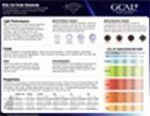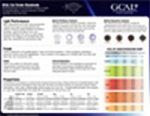lab SERVICES
Just what you want. GCAL offers a variety of lab services to fit your specific needs. From cut analysis to laser inscription
to QA & lab-grown diamond detection, GCAL's a' la carte services are customizable to meet your requirements.
CUT ANALYSIS
The most true-to-life method to assess CUT quality is by Direct Assessment technology
ViewPrecision cutting produces symmetrical patterning that is captured in hi-res photos
View
GCAL's Cut Grade system for Round and Fancy Shapes encompasses Light Performance and Proportions
ViewOptical Light Performance
Direct Assessment Light Performance
Diamonds are treasures from the Earth and color and clarity are natural phenomena, but cut is solely the result of the skill and artisanship of the cutter. Master craftsmen reveal the hidden beauty of diamonds in the rough. A well cut diamond is brilliant regardless of color and clarity.
How much a diamond reflects, refracts and releases its inner beauty is determined by how well it plays with light – its brilliance and symmetry. GCAL measures, captures and records each diamond’s individual light performance through direct assessment analysis.
There are many ways to assess if a diamond is well cut. For many years, the cut quality was judged by proportions, such as depth percentage and table percentage, but this system was based on 2-dimensional mathematics. In the early 1990s, diamantaires began discussing a need for a cut grading system more in agreement with the way diamonds actually appear to the eye.
The most true-to-life method that developed is Direct Assessment Light Performance analysis. This method analyzes the actual diamond and not a model, which means every nuance, such as inclusions and transparency, are considered.
In 1996, the Diamond Profile Laboratory was the first lab to illustrate and grade light performance. Diamond Profile Laboratory and its direct assessment technology were purchased in 2003 by GCAL laboratory. GCAL continues to use this proven and copyrighted technology to grade and evaluate light performance. Light Performance is analyzed in two categories, Optical Brilliance and Optical Symmetry.


Optical Brilliance Analysis
GCAL directly assesses the overall return of light to the viewer, called 'brilliance'.
The Optical Brilliance image is actually a digital photograph of the diamond taken in a special lighting environment that creates a strong contrast between the bright and dark areas. The image is then processed in a proprietary computer program that calculates the percentage of brilliance and the amount of light loss. This is a scientifically accurate and repeatable way to measure brilliance. The light gray areas of the image are facet outlines resulting from image processing to provide a realistic representation of the diamond's unique faceting.
In the Optical Brilliance Analysis image on the certificate, the white represents the light return and the blue represents areas of light loss. The light return is quantified based on measurable light return (aka - performance) and then graded as: Excellent, Very Good, Good, Fair or Poor.
There are many ways to assess if a diamond is well cut. For many years, the cut quality was judged by proportions, such as depth percentage and table percentage, but this system was based on 2-dimensional mathematics. In the early 1990s, diamantaires began discussing a need for a cut grading system more in agreement with the way diamonds actually appear to the eye.
Since the Optical Brilliance is measured by direct assessment, meaning that it is judged based on the way each diamond actually performs rather than a theoretical model, the brilliance image of each individual diamond will always look slightly different
Brilliance is what gives a diamond its life, and what makes a diamond shine from across a room. Diamonds with a low percentage of brilliance look dull and dark.

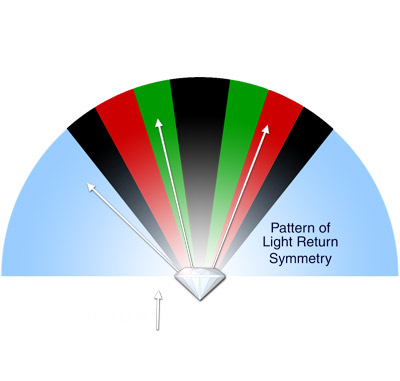
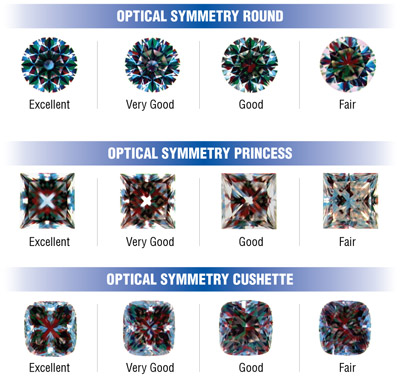
Optical Symmetry Analysis
Symmetry is the beauty and organization of everything in nature, science and art. Aesthetically pleasing proportions and balance represent perfection. Patterns repeated in radial or reflective symmetry have harmony. The symmetry of a diamond’s facets is in fact artwork created by the master craftsman who cut the diamond.
The Optical Symmetry Analysis image is a digital photograph taken of each diamond in a special lighting environment that reveals the patterns of light return. All light returned at the same angles is represented by the same color. For example, all red areas represent light being returned within a consistent angle range. Therefore, the Optical Symmetry assesses the consistency of angles and alignment of facets by looking at the equality of light return.
Since the Optical Symmetry is measured by direct assessment, meaning that it is judged based on the way each diamond actually performs rather than a theoretical model, the symmetry images of each individual diamond will always look slightly different. Like the beauty and ever changing color patterns in a kaleidoscope, each diamond reveals its unique reflective pattern of symmetry. You can judge the cut of a diamond yourself simply by examining the symmetry image–the more even the pattern, the better the symmetry.
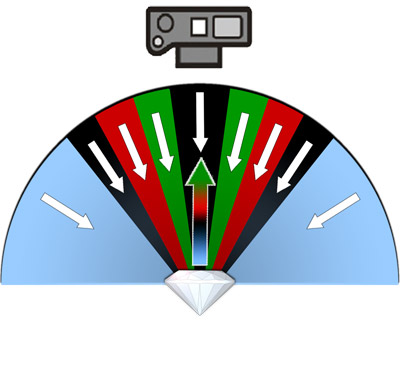

Heart & Arrows
Hearts & Arrows is a term used to describe the patterns visible in perfectly faceted round brilliant cut diamonds when they are examined in specialized viewers. Through these viewers, it is possible to assess the alignment and consistency of every facet by looking at the equality of light return, or the hearts and arrows patterns.
A precisely faceted round brilliant diamond exhibits a pattern of eight arrows through the crown (top) side, and a pattern of eight hearts through the pavilion (bottom) side.
Don't accept generic sample Hearts & Arrows images. When purchasing a Heart & Arrows diamond, be sure to either see the diamond in the viewer yourself or ask for a GCAL Heart & Arrows Certificate. GCAL is the only laboratory that takes a real photograph of each diamond in the specialized viewer. This means that the images on your GCAL Certificate are actually of your diamond. Unlike the majority of the Hearts & Arrows photos printed on other lab reports or seen online, which are either generic sample images applied to every diamond or are computer generated – neither of which guarantees that the diamond you're paying a premium for is actually deserving of the term Hearts & Arrow
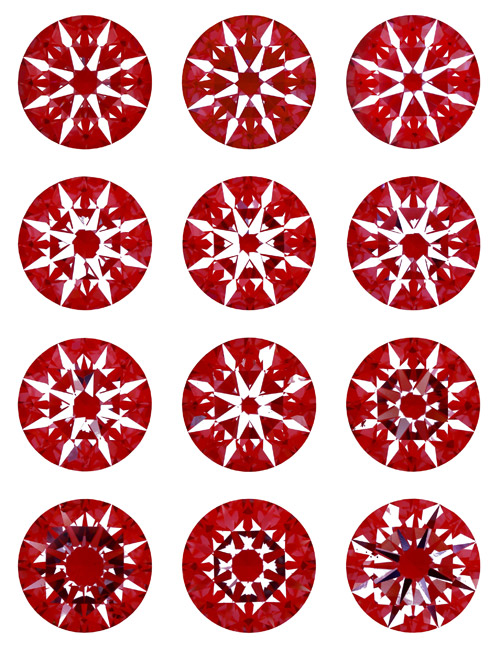
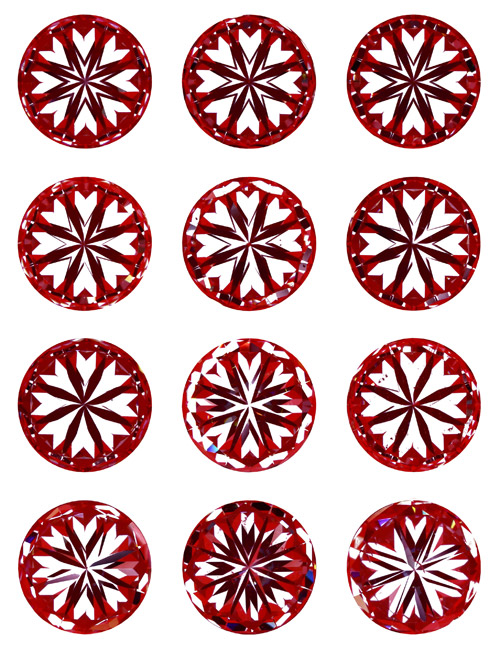
Not all diamonds make the cut. The top row has EXCELLENT Hearts & Arrows patterns. As you can see, the bottom row has no clear patterns. These images illustrate the importance of actual photographs of H&A vs. generic fake images found on some grading reports. Actual photographs, like the ones GCAL takes of each diamond, capture every slight deviation in faceting alignment so you get a true picture of your diamond.
The first row of images illustrates Ideal H& diamonds. The 2nd row of images shows diamonds that have Hearts & Arrows patterns but that are not perfectly Ideal. The 3rd row of images is examples of diamonds that are well cut but do not quite achieve the Hearts and Arrows designation. And the last row of images is examples of average cut-quality diamonds – definitely not Hearts & Arrows quality.
GCAL Cut Grade System
The GCAL Cut Grade encompasses ten factors to determine a diamond's light handling ability. These factors are separated into the categories of Light Performance, Finish and Proportions. The sum of these categories equals the total Cut Grade, with Ideal (100) being the highest possible grade.
A precisely faceted round brilliant diamond exhibits a pattern of eight arrows through the crown (top) side, and a pattern of eight hearts through the pavilion (bottom) side.






